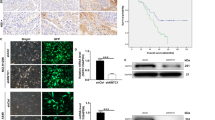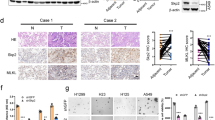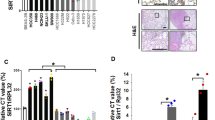Abstract
The S-phase kinase-associated protein-2 (SKP2) plays a key role in ubiquitin-mediated proteolysis, which results in the progression of cells from a quiescence to proliferative state. SKP2 is overexpressed in a variety of tumors. In this study, we used small interfering RNAs (siRNAs) to inhibit the SKP2 expression in lung cancer cells and thereby investigate the role of SKP2 in lung tumorigenesis. Three lung cancer cell lines were transfected with siRNAs targeted against SKP2. SKP2-siRNAs specifically and efficiently reduced the levels of the SKP2 protein by 90% 48 h after transfection in all cell lines. In the A549 and H1792 cells, p27 expression was increased and the increase was inversely proportional to the level of SKP2; cell proliferation was reduced to 12 and 28%, respectively; apoptosis was increased to 36 and 30%, respectively; 36 and 28% of cells accumulated in the sub-G1 phase, respectively; and the population of cells in the G1 phase was decreased to 37 and 41%, respectively. In addition, the SKP2-depleted A549 and H1792 cells showed decreased levels of cyclin E/CDK2. Correspondingly, only 4 and 6% of the treated A549 and H1792 cells had multiple centrosomes, respectively, compared with 43 and 46% of the control cells, respectively. These results imply that SKP2 plays an oncogenic role in lung cancer and that SKP2 silencing may be useful in the treatment of lung cancer.
This is a preview of subscription content, access via your institution
Access options
Subscribe to this journal
Receive 50 print issues and online access
$259.00 per year
only $5.18 per issue
Buy this article
- Purchase on Springer Link
- Instant access to full article PDF
Prices may be subject to local taxes which are calculated during checkout






Similar content being viewed by others
Abbreviations
- CDK:
-
cell cyclin cyclin-dependent protein kinase
- SKP2:
-
S-phase kinase-associated protein-2
- siRNAs:
-
small interfering RNAs
- MTT:
-
3-(4,5-dimethylthiazol-2-yl)-2,5,-diphenyl tetrazolium bromide
- FACS:
-
fluorescence-activated cell sorting
- TUNEL:
-
terminal deoxynucleotidyltransferase dUTP nick-end labeling
- DAPI:
-
4′,6-diamidino-2-phenylindole
References
Bhattacharya S, Garriga J, Calbo J, Yong T, Haines DS and Grana X . (2003). Oncogene, 16, 2443–2451.
Bloom J and Pagano M . (2003). Semin. Cancer Biol., 13, 41–47.
Brambilla E, Moro D, Gazzeri S and Brambilla C . (1999). J. Pathol., 188, 351–360.
Brinkley BR . (2001). Trends Cell. Biol., 11, 18–21.
Carrano AC, Eytan E, Hershko A and Pagano M . (1999). Nat. Cell Biol., 1, 193–199.
Chiarle R, Fan Y, Piva R, Boggino H, Skolnik J, Novero D, Palestro G, De Wolf-Peeters C, Chilosi M, Pagano M and Inghirami G . (2002). Am. J. Pathol., 160, 1457–1466.
Connor MK, Kotchetkov R, Cariou S, Resch A, Lupetti R, Beniston RG, Melchior F, Hengst L and Slingerland JM . (2003). Mol. Biol. Cell., 14, 201–213.
Dai C and Krantz SB . (1999). Blood, 93, 3309–3316.
Dao MA, Taylor N and Nolta JA . (1998). Proc. Natl. Acad. Sci. USA, 95, 13006–13011.
Deng CX . (2002). Oncogene, 21, 6222–6227.
Elbashir SM, Lendeckel W and Tuschl T . (2001). Genes Dev., 15, 188–200.
Foster JS, Fernando RI, Ishida N, Nakayama KI and Wimalasena J . (2003). J. Biol. Chem., 278, 41355–41366.
Freed E, Lacey KR, Huie P, Lyapina SA, Deshaies RJ, Stearns T and Jackson PK . (1999). Genes Dev., 13, 2242–2257.
Fukuse T, Hirata T, Naiki H, Hitomi S and Wada H . (2000). Cancer Res., 60, 242–244.
Gstaiger M, Jordan R, Lim M, Catzavelos C, Mestan J, Slingerland J and Krek W . (2001). Proc. Natl. Acad. Sci. USA, 98, 5043–5048.
Gstaiger M, Marti A and Krek W . (1999). Exp. Cell Res., 247, 554–562.
Harper JW . (2002). Curr. Biol., 11, 431–435.
Hara T, Kamura T, Nakayama K, Oshikawa K, Hatakeyama S and Nakayama K . (2001). J. Biol. Chem., 276, 48937–48943.
Hinchcliffe EH, Li C, Thompson EA, Maller JL and Sluder G . (1999). Science, 283, 851–854.
Jiang F, Caraway NP, Sabichi AL, Zhang HZ, Ruitrok A, Grossman HB, Gu J, Lerner SP, Lippman S and Katz RL . (2003). Int. J. Cancer, 106, 661–665.
Kawana H, Tamaru J, Tanaka T, Hirai A, Saito Y, Kitagawa M, Mikata A, Harigaya K and Kuriyama T . (1998). Am. J. Pathol., 2, 505–513.
Kaye FJ . (2002). Oncogene, 21, 6908–6914.
Kudo Y, Kitajima S, Sato S, Miyauchi M, Ogawa I and Takata T . (2001). Cancer Res., 61, 7044–7047.
Lacey KR, Jackson PK and Stearns T . (1999). Proc. Natl. Acad. Sci. USA, 96, 2817–2822.
Latres E, Chiarle R, Schulman BA, Pavletich NP, Pellicer A, Inghirami G and Pagano M . (2001). Proc. Natl. Acad. Sci. USA, 98, 2515–2520.
Lim MS, Adamson A, Lin Z, Perez-Ordonez B, Jordan RC, Tripp S, Perkins SL and Elenitoba-Johnson KS . (2002). Blood, 100, 2950–2956.
Lingle WL, Barrett SL, Negron VC, D'Assoro AB, Boeneman K, Liu W, Whitehead CM, Reynolds C and Salisbury JL . (1998). Proc. Natl. Acad. Sci. USA, 99, 1978–1983.
Lisztwan J, Imbert G, Wirbelauer C, Gstaiger M and Krek W . (1999). Genes Dev., 13, 1822–1833.
Malek NP, Sundberg H, McGrew S, Nakayama K, Kyriakides TR, Roberts JM and Kyriakidis TR . (2001). Nature, 413, 323–327.
Martinez LA, Naguibneva I, Lehrmann H, Vervisch A, Tchenio T, Lozano G and Harel-Bellan A . (2002). Proc. Natl. Acad. Sci. USA, 99, 14849–14854.
Masuda TA, Inoue H, Sonoda H, Mine S, Yoshikawa Y, Nakayama K, Nakayama K and Mori M . (2002). Cancer Res., 62, 3819–3825.
McManus MT and Sharp PA . (2002). Nat. Rev. Genet., 3, 737–747.
Meraldi P, Lukas J, Fry AM, Bartek J and Nigg EA . (1999). Nat. Cell Biol., 1, 88–93.
Murphy TD . (2003). J. Cell Sci., 116, 2321–2332.
Nakayama K, Nagahama H, Minamishima YA, Matsumoto M, Nakamichi I, Kitagawa K, Shirane M, Tsunematsu R, Tsukiyama T, Ishida N, Kitagawa M, Nakayama K and Hatakeyama S . (2000). EMBO J., 19, 2069–2081.
Nakayama K, Nagahama H, Minamishima YA, Miyake S, Ishida N, Hatakeyama S, Kitagawa M, Iemura S, Natsume T and Nakayama KI . (2004). Dev. Cell, 6, 661–672.
Nigg EA . (2002). Nat. Rev. Cancer, 2, 815–825.
Oliveira AM, Okuno SH, Nascimento AG and Lloyd RV . (2003). J. Clin. Oncol., 21, 722–727.
Okuda M, Horn HF, Tarapore P, Tokuyama Y, Smulian AG, Chan PK, Knudsen ES, Hofmann IA, Snyder JD, Bove KE and Fukasawa K . (2000). Cell, 103, 127–140.
Pagano M . (2004). Mol. Cell, 21, 414–416.
Park KH, Seol JY, Yoo CG, Kim YW, Han SK, Lee EH, Kim CM, Shim YS and Lee CT . (2001). Lung Cancer, 31, 149–155.
Pihan GA, Purohit A, Wallace J, Knecht H, Woda B, Quesenberry P and Doxsey SJ . (1998). Cancer Res., 58, 3974–3985.
Piva R, Liu J, Chiarle R, Podda A, Pagano M and Inghirami G . (2002). Mol. Cell. Biol., 22, 8375–8387.
Rubinson DA, Dillon CP, Kwiatkowski AV, Sievers C, Yang L, Kopinja J, Zhang M, McManus MT, Gertler FB, Scott ML and Van Parijs L . (2003). Nat. Genet., 33, 401–406.
Ruffner H, Joazeiro CA, Hemmati D, Hunter T and Verma I M . (2001). Proc. Natl. Acad. Sci. USA, 98, 5134–5139.
Saavedra HI, Knauf JA, Shirokawa JM, Wang J, Ouyang B, Elisei R, Stambrook PJ and Fagin JA . (2000). Oncogene, 19, 3948–3954.
Sen S, Zhou H, Zhang RD, Yoon DS, Vakar-Lopez F, Ito S, Jiang F, Johnston D, Grossman HB, Ruifrok AC, Katz RL, Brinkley W and Czerniak B . (2002). J. Natl. Cancer Inst., 94, 1320–1329.
Shigemasa K, Gu L, O'Brien TJ and Ohama K . (2003). Clin. Cancer Res., 9, 1756–1763.
Shim EH, Johnson L, Noh HL, Kim YJ, Sun H, Zeiss C and Zhang H . (2003). Cancer Res., 63, 1583–1588.
Slingerland J and Pagano M . (2000). J. Cell. Physiol., 183, 10–17.
Tarapore P and Fukasawa K . (2002). Oncogene, 21, 6234–6240.
Thyrell L, Erickson S, Zhivotovsky B, Pokrovskaja K, Sangfelt O, Castro J, Einhorn S and Grander D . (2002). Oncogene, 21, 1251–1262.
Vidwans SJ, Wong ML and O'Farrell PH . (1999). J. Cell Biol., 147, 1371–1378.
von der Lehr N, Johansson S, Wu S, Bahram F, Castell A, Cetinkaya C, Hydbring P, Weidung I, Nakayama K, Nakayama KI, Soderberg O, Kerppola TK and Larsson LG . (2003). Mol. Cell, 11, 1189–1200.
Volm M, Koomagi R and Rittgen W . (1998). Int. J. Cancer, 79, 199–294.
Wang XW, Zhan Q, Coursen JD, Khan MA, Kontny HU, Yu L, Hollander MC, O'Connor PM, Fornace AJ and Harris C . (1999). Proc. Natl. Acad. Sci. USA, 96, 3706–3711.
Yang G, Ayala G, Marzo AD, Tian W, Frolov A, Wheeler TM, Thompson TC and Harper JW . (2002). Clin. Cancer Res., 8, 3419–3426.
Yeh KH, Kondo T, Zheng J, Tsvetkov LM, Blair J and Zhang H . (2001). Biochem. Biophys. Res. Commun., 281, 884–890.
Yokoi S, Yasui K, Iizasa T, Takahashi T, Fujisawa T and Inazawa J . (2003). Cancer Sci., 94, 344–349.
Yokoi S, Yasui K, Saito-Ohara F, Koshikawa K, Iizasa T, Fujisawa T, Terasaki T, Horii A, Takahashi T, Hirohashi S and Inazawa J . (2000). Am. J. Pathol., 161, 207–216.
Zhou H, Kuang J, Zhong L, Kuo WL, Gray JW, Sahin A, Brinkley BR and Sen S . (1998). Nat. Genet., 20, 189–193.
Zhu CQ, Blackhall FH, Pintilie M, Iyengar P, Liu N, Ho J, Chomiak T, Lau D, Winton T, Shepherd FA and Tsao MS . (2004). Clin. Cancer Res., 6, 1984–1991.
Acknowledgements
This work was supported by an M Keck Center for Cancer Gene Therapy Award, The University of Texas MD Anderson Cancer Center Institutional Research Grant, and a Developmental Project/Career Development Award from The University of Texas Specialized Programs of Research Excellence in Lung Cancer (to FJ). We thank Beth Notzon, Gayle Nesom, and Karen F Phillips for critical reading of this manuscript.
Author information
Authors and Affiliations
Corresponding author
Rights and permissions
About this article
Cite this article
Jiang, F., Caraway, N., Li, R. et al. RNA silencing of S-phase kinase-interacting protein 2 inhibits proliferation and centrosome amplification in lung cancer cells. Oncogene 24, 3409–3418 (2005). https://doi.org/10.1038/sj.onc.1208459
Received:
Revised:
Accepted:
Published:
Issue Date:
DOI: https://doi.org/10.1038/sj.onc.1208459
Keywords
This article is cited by
-
Upregulation of kinesin family member 4A enhanced cell proliferation via activation of Akt signaling and predicted a poor prognosis in hepatocellular carcinoma
Cell Death & Disease (2018)
-
Attenuation of teratoma formation by p27 overexpression in induced pluripotent stem cells
Stem Cell Research & Therapy (2016)
-
Hepatitis B Virus Core Promoter A1762T/G1764A (TA)/T1753A/T1768A Mutations Contribute to Hepatocarcinogenesis by Deregulating Skp2 and P53
Digestive Diseases and Sciences (2015)
-
Silencing of KIF14 interferes with cell cycle progression and cytokinesis by blocking the p27Kip1 ubiquitination pathway in hepatocellular carcinoma
Experimental & Molecular Medicine (2014)
-
Gene delivery of cyclin-dependent kinase inhibitors p21 Waf1 and p27 Kip1 suppresses proliferation of MCF-7 breast cancer cells in vitro
Breast Cancer (2014)



